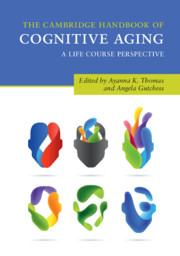Book contents
- The Cambridge Handbook of Cognitive Aging
- The Cambridge Handbook of Cognitive Aging
- Copyright page
- Contents
- Figures
- Tables
- Contributors
- Introduction
- Part I Models of Cognitive Aging
- Part II Mechanisms of Cognitive Aging
- 7 Aging Effects on Brain and Cognition: What Do We Learn from a Strategy Perspective?
- 8 Inhibitory Theory: Assumptions, Findings, and Relevance to Interventions
- 9 From Perception to Action: Bottom-Up and Top-Down Influences on Age Differences in Attention
- 10 Age-Related Sensory Deficits and Their Consequences
- 11 Episodic Memory Decline in Aging
- 12 Age Differences in Decision Making
- 13 Emotion and Memory
- 14 Time Perception from Seconds to Lifetimes: How Perceived Time Affects Adult Development
- Part II Summary: Mechanisms of Cognitive Aging
- Part III Aging in a Socioemotional Context
- Part IV Cognitive, Social, and Biological Factors across the Lifespan
- Part V Later Life and Interventions
- Index
- Plate Section (PDF Only)
- References
8 - Inhibitory Theory: Assumptions, Findings, and Relevance to Interventions
from Part II - Mechanisms of Cognitive Aging
Published online by Cambridge University Press: 28 May 2020
- The Cambridge Handbook of Cognitive Aging
- The Cambridge Handbook of Cognitive Aging
- Copyright page
- Contents
- Figures
- Tables
- Contributors
- Introduction
- Part I Models of Cognitive Aging
- Part II Mechanisms of Cognitive Aging
- 7 Aging Effects on Brain and Cognition: What Do We Learn from a Strategy Perspective?
- 8 Inhibitory Theory: Assumptions, Findings, and Relevance to Interventions
- 9 From Perception to Action: Bottom-Up and Top-Down Influences on Age Differences in Attention
- 10 Age-Related Sensory Deficits and Their Consequences
- 11 Episodic Memory Decline in Aging
- 12 Age Differences in Decision Making
- 13 Emotion and Memory
- 14 Time Perception from Seconds to Lifetimes: How Perceived Time Affects Adult Development
- Part II Summary: Mechanisms of Cognitive Aging
- Part III Aging in a Socioemotional Context
- Part IV Cognitive, Social, and Biological Factors across the Lifespan
- Part V Later Life and Interventions
- Index
- Plate Section (PDF Only)
- References
Summary
Inhibitory theory proposes three major functions that are required to control overactivation in response to cues in the environment and thought. Evidence suggests that each function, Access, Deletion, and Restraint, is reduced in efficiency in healthy older adults. These reductions can together account for slowing, reduced working memory capacity, and increased susceptibility to interference at retrieval – all memory phenomena associated with aging. These reductions also result in greater knowledge of the context in which events occur as well as in greater usage of that information. Opportunities for positive interventions tied to these inefficiencies are also noted.
Keywords
Information
- Type
- Chapter
- Information
- The Cambridge Handbook of Cognitive AgingA Life Course Perspective, pp. 147 - 160Publisher: Cambridge University PressPrint publication year: 2020
References
Accessibility standard: Unknown
- 6
- Cited by
